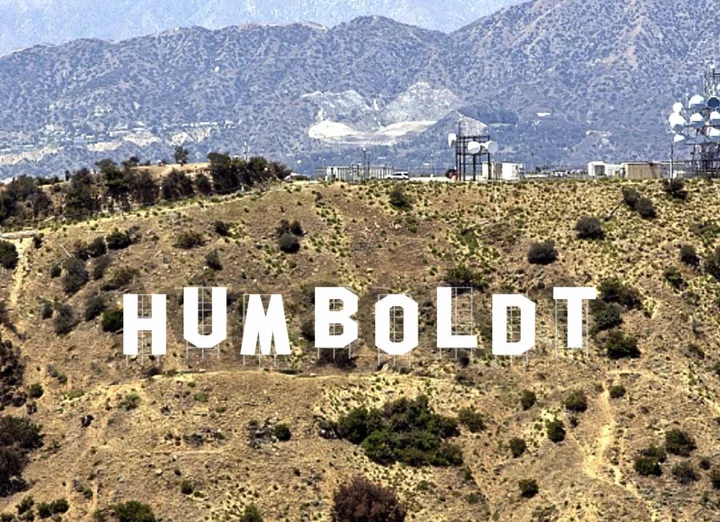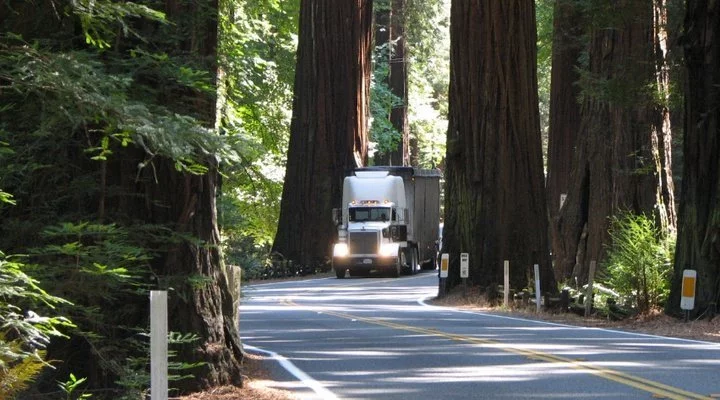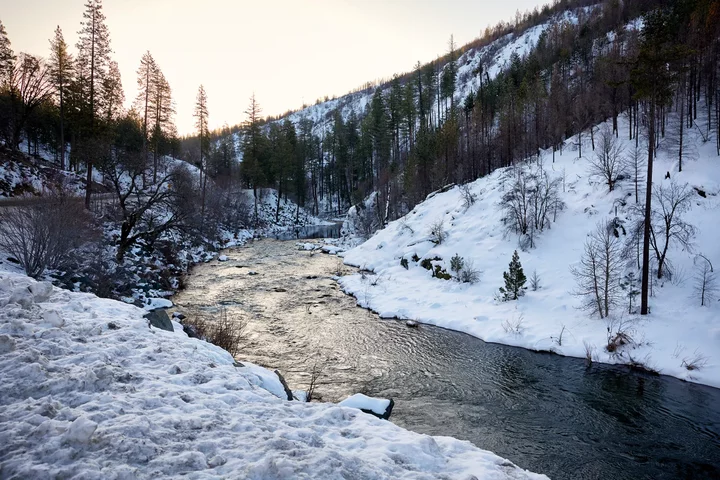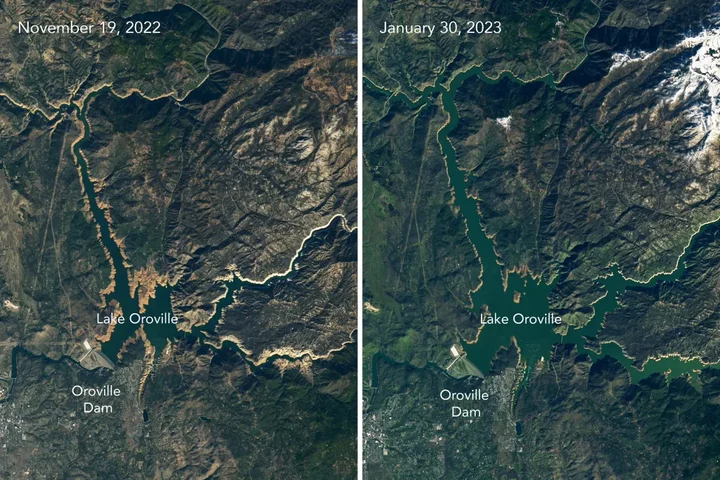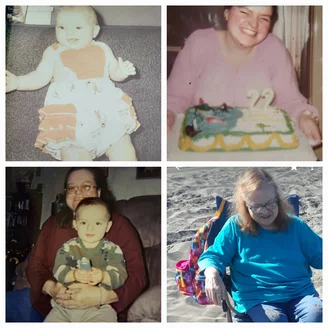HUMBOLDT TODAY with John Kennedy O’Connor | March 10, 2023
LoCO Staff / Friday, March 10, 2023 @ 4:36 p.m. / Humboldt Today
HUMBOLDT TODAY: We’re not out of the woods yet, folks. A wet weekend ahead could add to the weather-related woes making life on the North Coast more difficult. But the good news is Humboldt Today has decided you get to pick this year’s Best Picture. You lose some, you win some. Those stores and more on today’s newscast with John Kennedy O’Connor.
FURTHER READING:
- Will Eureka Finally See Development on the Big Gravel Lots by the Boardwalk? City Looks to Declare the Parcels Surplus and Seek Proposals for Mixed-Use Project.
- Fortuna Police Conduct Old-Fashioned Weed Bust Downtown; 100 Pounds, Plus Money, Guns and Shrooms, Confiscated; One Arrested
- Yurok Tribe Taps Law Enforcement Veteran to Investigate MMIP Cases
- California Storms Create Paradox: Too Much Water in Reservoirs, Too Soon
- Rio Dell’s Long-Suffering Sewage System Took Another Dump Tonight
HUMBOLDT TODAY can be viewed on LoCO’s homepage each night starting at 6 p.m.
Want to LISTEN to HUMBOLDT TODAY? Subscribe to the podcast version here.
BOOKED
Yesterday: 6 felonies, 8 misdemeanors, 0 infractions
JUDGED
Humboldt County Superior Court Calendar: Today
CHP REPORTS
8th Ave / Westhaven Dr S (HM office): Traffic Hazard
ELSEWHERE
Washington Post: Oregon tribe harvests its first whale in generations
NPR: After federal funding cuts, tribal radio station says silence is not an option
NPR: Family of Colombian man killed in U.S. strike files human rights challenge
KJZZ: Most people in ICE custody have no criminal convictions, Cato Institute report says
Richardson Grove Conflict Heads to Round Four as Conservation Groups File Legal Challenge to Caltrans’ 101 Realignment Project
LoCO Staff / Friday, March 10, 2023 @ 3:43 p.m. / Environment , Transportation
File photo via Caltrans.
Press release from EPIC and the Center for Biological Diversity:
Conservation groups and Humboldt residents filed a legal challenge this week to a fourth attempt by Caltrans to approve the controversial Richardson Grove Project.
The project would realign portions of Highway 101 through Richardson Grove State Park to facilitate oversized commercial truck traffic, risking damage to a grove of ancient redwoods that are up to 3,000 years old. To realign the road, Caltrans proposes cutting and paving over roots of adjacent old-growth redwood trees.
The challenge was brought by the Center for Biological Diversity, Environmental Protection Information Center, Californians for Alternatives to Toxics, Friends of Del Norte, and several individual Humboldt residents with generational family ties to Richardson Grove.
“In its unrelenting pursuit of this unnecessary and fiscally foolish highway construction project, Caltrans has ignored its obligations to adequately evaluate the environmental impacts and is prepared to sacrifice the iconic Richardson Grove and desecrate our state park,” said Peter Galvin, director of programs at the Center for Biological Diversity. “We simply can’t and won’t let this beloved remnant of primeval forest be damaged.”
“Caltrans has pulled the same play from the playbook: Deny obvious impacts and push ahead,” said Tom Wheeler, executive director of the Environmental Protection Information Center. “We are stuck in a Groundhog Day nightmare where the agency refuses to take accountability for its sloppy work.”
“The fact that Caltrans refutes as ‘non informative’ new scientific research on the effects of paving over the roots of redwood trees demonstrates the callous nature of their dogged approach to completing this needless project,” said Don Gillespie of the Friends of Del Norte. “Richardson Grove deserves better.”
The recent Caltrans approval of the project violates the California Environmental Quality Act, a state law that requires public agencies to evaluate and disclose the environmental impacts of a project and to limit or avoid those impacts to the extent feasible. Caltrans failed to prepare an environmental impact report for the project, did not consider or evaluate significant environmental impacts, did not adopt effective and enforceable mitigation measures, and failed to circulate a valid environmental review document for public review and comment. Each prior approval of this unnecessary road widening project has been halted by legal action and a state or federal court stop work order.
Since the project’s inception in 2007, new research published in 2021 has documented how cutting and paving over the roots of old-growth redwoods causes long-term harms to coast redwood forests.Researchers with the California Department of Forestry, Utah State University and Michigan Technological University found that road construction significantly harmed adjacent old-growth at Humboldt Redwoods State Park, causing growth suppression, elevated water stress and crown dieback of redwoods. This study and other evidence was submitted to Caltrans but the agency has denied that the research could better inform the project.
Richardson Grove State Park is considered the gateway to the redwoods, where tourists often first encounter large redwoods when heading north on Highway 101. It is home to one of the last protected stands of accessible old-growth redwood trees in the world. The park has essential habitat for protected species, and its creeks support runs of imperiled salmon and steelhead trout.
The plaintiffs are represented by the law firm Gross Klein PC. The CEQA case filed on March 7, 2023 is #CV2300375.
###
Asked about the latest developments with the project last week, Caltrans District 1 sent the Outpost the following statement:
The Richardson Grove Improvement Project along U.S. 101 in southern Humboldt County would make minor adjustments to the current alignment of the highway to accommodate industry-standard STAA trucks. The project would improve the movement of goods in and out of the area. No old-growth trees would be removed and the roadway would look much the same after construction. Additionally, the project’s limited root disturbance would not affect the continued health of old-growth redwoods in the project area. For this proposed project, Caltrans recently made available the Responses to Comments on the Addendum to the Final Environmental Impact Report. Those responses are available here. For up-to-date project information, please visit the project web page.
Fortuna Police Conduct Old-Fashioned Weed Bust Downtown; 100 Pounds, Plus Money, Guns and Shrooms, Confiscated; One Arrested
LoCO Staff / Friday, March 10, 2023 @ 12:26 p.m. / Crime
Press release from the Fortuna Police Department:
On March 8, 2023 at approximately 1030 hours, the Fortuna Police Department responded the 500 block of 9th street, to conduct a probation compliance search of a residence belonging to 39-year old Jarrett James Stergiou.
Upon arriving, Officers contacted Stergiou and located the following items inside his home during a probation compliance check.
1. Approximately one hundred pounds of marijuana, which included several pounds of processed and packaged marijuana for sales.
2. Psilocybin Mushrooms
3. Live handgun ammunition
4. Approximately $45,000.00 dollars in U.S. CurrencyMr. Stergiou denied ownership of the cash and it was further determined that Stergiou is a convicted felon and prohibited from possessing firearms or ammunition.
Mr. Stergiou was subsequently arrested and transported to the Humboldt County Correctional Facility where he was booked for the following charges:
1. California Penal Code 30305(a)(1)- Felon in possession of ammunition
2. California Penal Code 1203.2(a)- Probation violation
3. Health and Safety Code 11377(a)- Possession of a controlled substance
4. Health and Safety Code 11359(b)- Possession of marijuana for sales
5. Health and Safety Code 11357(b)- Possession of over 1 ounce/28.5 grams of marijuanaThe Fortuna Police Department was assisted by the Humboldt County Drug Task Force and the Humboldt County Marijuana Eradication Team. Any questions regarding this incident can be directed to the Patrol Commander, Lieutenant Matthew Eberhardt at (707)-725-7550.
California Storms Create Paradox: Too Much Water in Reservoirs, Too Soon
Alastair Bland / Friday, March 10, 2023 @ 7 a.m. / Sacramento
Snow melted into the South Fork of the American River in the Sierra Nevada on March 3, 2023. Photo by Fred Greaves, California Department of Water Resources.
Two winters’ worth of snow has already fallen in the Sierra Nevada since Christmas, pulling California from the depths of extreme drought into one of its wettest winters in memory.
But as a series of tropical storms slams the state, that bounty has become a flood risk as warm rains fall on the state’s record snowpack, causing rapid melting and jeopardizing Central Valley towns still soggy from January’s deluges.
The expected surge of mountain runoff forced state officials on Wednesday to open the “floodgates” of Lake Oroville and other large reservoirs that store water for millions of Southern Californians and Central Valley farms. Releasing the water will make room for the storm’s water and melted snow, prevent the reservoirs from flooding local communities — and send more water downstream, into San Francisco Bay. The increased flows in the Sacramento-San Joaquin Delta could help endangered salmon migrate to the ocean.
So what’s the downside? These same storms are prematurely melting a deep and valuable snowpack that ideally would last later into the spring and summer, when farmers and cities need water the most.
The storms have created a tricky situation for officials who manage state and federal reservoirs in California, since they have to juggle the risk of flooding Central Valley communities with the risk of letting too much water go from reservoirs. They must strike a balance between holding as much water in storage, as long as they can, while maintaining room in reservoirs for more water later in the season.
“Water management in California is complicated, and it’s made even more complex during these challenging climate conditions where we see swings between very, very dry, very, very wet, back to dry. We’re now back into wet,” said Karla Nemeth, director of the Department of Water Resources.
Rivers in the San Joaquin Valley are forecast to flood today or Saturday. Eleven locations are expected to reach the flood stage, although no “danger stage” flooding is anticipated, according to Jeremy Arrich, deputy director of the Division of Flood Management with the Department of Water Resources.
To make room for more water, state and federal officials who manage California’s major dams and reservoirs are releasing water. Some will flow into the ocean — which aggravates many water managers, Central Valley legislators and growers, who often say freshwater that reaches the bay or ocean is wasted. However, efforts are underway to divert much of the released water into depleted groundwater storage basins.
On Wednesday, the Department of Water Resources increased outflow of water from Oroville from about 1,000 cubic feet per second to 3,500 cubic feet per second. By Friday, total releases could be as high as 15,000 cubic feet per second, according to Ted Craddock, deputy director of the State Water Project.
Oroville is now more than 75% full, containing 2.7 million acre-feet of water — up from less than one million in the beginning of December. In spite of releases, the reservoir’s level will keep rising. Craddock said inflow in the next five days could hit 70,000 cubic feet per second. That’s about half a million gallons of water per second.
Satellite images show how January storms boosted water levels in parched Lake Oroville, one of the state’s largest reservoirs. State officials released water from the reservoir this week in anticipation of another major storm. Photos via NASA Earth Observatory.
In 2017 Oroville’s levels reached so high that the overflow water damaged its spillway. An emergency spillway had to be used, eroding a hillside and triggering evacuation of about 200,000 people in nearby communities.
The U.S. Bureau of Reclamation announced a similar operational move for Millerton Lake, the reservoir behind Friant Dam on the San Joaquin River, which supplies water to growers throughout the Central Valley.
The two-day rainfall totals will be “quite astounding” and “will lead to some really significant runoff,” said State Climatologist Michael Anderson. More storms are expected next week and later in March.
Rain on snow
Today’s storm is creating what watershed scientists and weather watchers call a “rain on snow” event. Earlier this winter, freezing elevations hovered as low as 3,000 feet, meaning precipitation above that fell as snow.
That has changed, Anderson said. Freezing levels have risen to as high as 7,000 feet in the southern and central Sierra Nevada, where the bulk of the snowpack has accumulated. A National Weather Service forecast shows freezing elevations even higher, at 9,000 feet, and warned that “snow will melt easily below 5,000 feet,” since it is already approaching the melting point of 32 degrees Fahrenheit.
State officials say the premature snowmelt from this storm likely won’t have much effect on supplies this spring and summer.
“This winter, there has been an accumulation of snow at lower to mid-level elevations, which will experience melt during this storm and will generate runoff into foothill and valley communities,” said David Rizzardo, manager of the state water agency’s hydrology section.
“However, at higher elevations, where the vast majority of the snowpack is, we will not experience significant melt. Even with higher snow levels above 8,000 feet in these storms, we still anticipate seeing additional snow accumulation at the higher elevations that will add to our snowpack totals, especially in the Southern Sierra.”
John Abatzoglou, a UC Merced professor of climatology, said deep, soft snow has the physical capacity to absorb a great deal of rain. The snow may even freeze the rain, rather than vice-versa, effectively increasing the snowpack volume, at least for a while.
“As you add liquid to the snowpack, it gets denser, it gets warm, and it gets more apt to melt when the next storm comes,” he said, noting that more atmospheric river events are coming next week.
Diverting underground
While the latest storms flood river valleys, state regulators have taken action to capture as much stormwater as possible before it flows into the ocean and use it to recharge groundwater basins.
On Wednesday, the State Water Resources Control Board approved a petition from the Bureau of Reclamation to divert 600,000 acre-feet of San Joaquin Valley flood waters into wildlife refuges and groundwater recharge basins. Diversions can begin on March 15 and continue until July.
“Given the time it takes for water to reach the downstream point of diversion at Mendota Dam, the approval period will allow for floodwater capture following storms expected this weekend,” the water board explained in a news release.
The action is intended in part to help meet Gov. Gavin Newsom’s goal of increasing groundwater storage by over 500,000 acre-feet per year, spelled out in his Water Supply Strategy released last summer.
But environmental groups protested the water board’s action.
Greg Reis, a hydrologist with The Bay Institute, said it will allow the bureau to divert all of the San Joaquin River except for 300 cubic feet per second — what he calls “a very, very small” amount of water. Floodwaters, he said, are important for ecosystem function and survival of fish, including threatened spring-run Chinook salmon.
He compared floodwaters in a river to a person’s increased pulse when they exercise.
“If you don’t get your heart rate up when you exercise, you don’t get the health benefits,” he said. “Same thing for a river. You’ve got to get the flows up, and the 300 cubic feet per second is certainly not adequate for a river like the San Joaquin.”
###
CalMatters.org is a nonprofit, nonpartisan media venture explaining California policies and politics.
OBITUARY: Linda D. Parker, 1956-2022
LoCO Staff / Friday, March 10, 2023 @ 6:56 a.m. / Obits
Linda D. Parker (Lakey) was born Wednesday January 4, 1956 at Trinity Hospital in Arcata. Her parents were Doris & Greg (Pierce) Lakey Jr.
She had two brothers, Ronald (wife Renee) and David (wife Angela), and a sister, Patricia. She had three daughters, including Lacy Renee Ramey and Lauren Marissa Parker. Lacy lives in Arkansas and has three children: Quentin, Kennedi and Adalyn, along with new granddaughter Nova. Lauren lives here in Eureka with her husband Don; they have two children, Myah and Kyle, and Myah has two daughters: Effie and Gemma.
Linda loved spending time with family, especially at the holidays. Before her health stopped her she loved combing the beaches for agates.
She always had a shy nature to her, but once she opened up she was very funny. She had great stories from when she lived in both Alaska and Arkansas. She also lived in Los Angeles for a little while when joining the Job Corps. She bragged about the fact that she lived on the 9th floor with no elevator.
She loved video games — everything from Animal Crossing to slaying dragons in Skyrim, which she rocked at. She also had a cat named Boo who she loved very much. She loved the San Francisco Giants and 49ers. (4ever faithful). As we will always be to you. Luv u Mom — LMP.
If you see a stray animal in need, always do the best to help of your ability, even if it’s just a phone call to your local police department.
###
The obituary above was submitted on behalf of Linda Parker’s loved ones. The Lost Coast Outpost runs obituaries of Humboldt County residents at no charge. See guidelines here. Email news@lostcoastoutpost.com.
HUMBOLDT TODAY with John Kennedy O’Connor | March 9, 2023
LoCO Staff / Thursday, March 9, 2023 @ 5:07 p.m. / Humboldt Today
HUMBOLDT TODAY: It’s going to be a rough night, Humboldt. High winds and rain will batter the North Coast. Plus, dramatic testimony in former Arcata City Councilmember Brett Watson’s restraining order hearing. Those stores and more on today’s newscast with John Kennedy O’Connor.
FURTHER READING:
HUMBOLDT TODAY can be viewed on LoCO’s homepage each night starting at 6 p.m.
Want to LISTEN to HUMBOLDT TODAY? Subscribe to the podcast version here.
Deputies Seeking Suspects in McKinleyville Home Invasion Robbery Tuesday Night, Sheriff’s Office Says
LoCO Staff / Thursday, March 9, 2023 @ 4:19 p.m. / Crime
Press release from the Humboldt County Sheriff’s Office:
On March 7, 2023, at about 7:39 p.m., Humboldt County Sheriff’s deputies were dispatched to a residence on the 1600 block of Bartow Road in McKinleyville for the report of a home invasion armed robbery.
At the residence, deputies contacted an adult female victim. The victim told deputies that she had been inside the residence when an unknown man entered through the unlocked front door. The man reportedly brandished a firearm at the victim and then zip-tied her wrists together. The man reportedly demanded cash and struck the victim with his fist. A second suspect reportedly arrived and together, the suspects ransacked the residence, stealing a large amount of cash. The victim did not sustain visible injuries as a result of this incident.
The suspects remain outstanding at this time. The victim was only able to describe one suspect as a Spanish-speaking Hispanic male adult, approximately 5 feet 10 inches tall, heavyset build and a buzzed head.
This case is still under investigation. Anyone with information about this case or related criminal activity is encouraged to call the Humboldt County Sheriff’s Office at (707) 445-7251 or the Sheriff’s Office Crime Tip line at (707) 268-2539.

